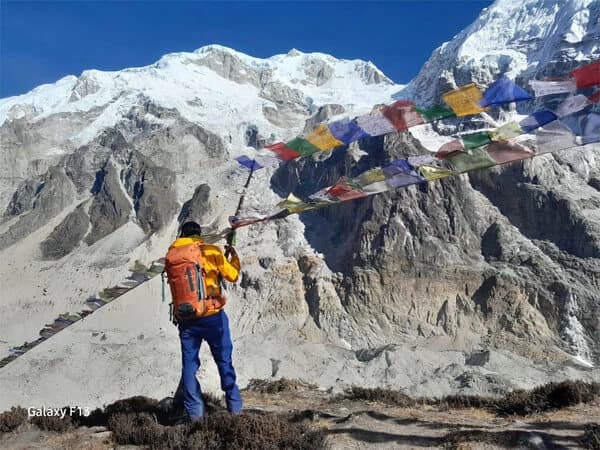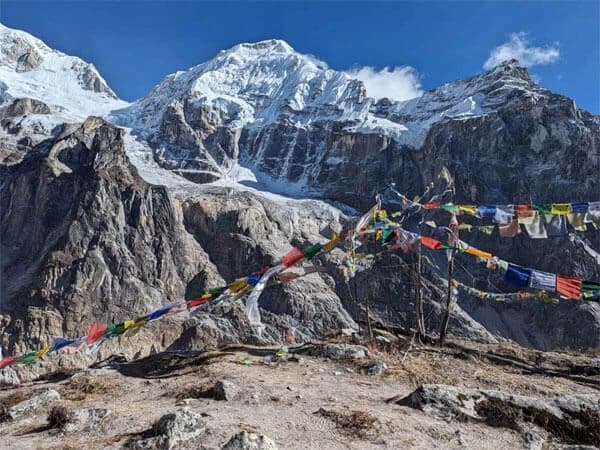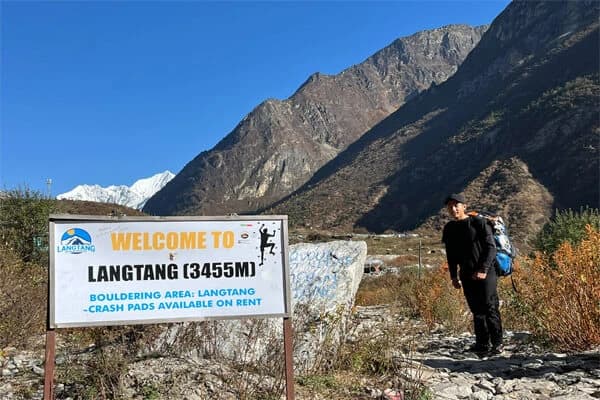The Kanchenjunga base camp trek 19 days itinerary is a challenging trek in Nepal offering adventures an unforgettable experienc on remote trekking routes. This high altitude trekking journey in Nepal Himalayas is a moderate to strenuous trek, requeiring good fitness and acclimatization.
Visiting to Kanchenjunga restricted area trekkers must obtain a special trekking permit for Kanchenjunga trek. The best season for the Kanchenjunga circuit trek is spring trekking in Nepal (March-May) and autumn trekking in Nepal (September-November), with clear skies and stable weather.
This trek can be done as a tea house trek in Kanchenjunga but certain sections may require a camping trek in Nepal. Kanchenjunga trek is done with hiring guide and porter is essential for safety and convenience.
Given the remote nature of the region, it’s highly recommended to undertake this trek with an experiencedlocal trekking agency such as Nepal Trekking Routes, which specializes in guiding trekkers through this rugged terrain, providing logistical support, professional guides, and ensuring your safety.
Here is a comprehensive itinerary that takes you through the North and South Base Camps of Kanchenjunga, acclimatization days, cultural experiences, and essential trekking details.
Kanchenjunga Base Camp Trek day-by-day Itinerary
Arrival in Kathmandu
Upon arriving at Tribhuvan International Airport, you'll be welcomed by a representative from Nepal Trekking Routes and transferred to your hotel. Spend the day resting or exploring the vibrant city of Kathmandu. In the evening, there will be a pre-trek briefing with your trekking guide, discussing the itinerary, necessary gear, and permits. You can also take time to explore Thamel, a popular tourist area known for its restaurants, shops, and trekking stores. Overnight stay at a hotel in Kathmandu, preparing for the adventure ahead.
Kathmandu Valley Sightseeing and trek preparation
Kathmandu sightseeing Tour is a vibrant hub of culture and history, offering rich experiences for trekkers before their adventure. Begin your exploration at Swayambhunath Stupa, also known as the Monkey Temple, perched on a hill with panoramic views of the valley and the Himalayas. This ancient site is adorned with prayer flags and offers a spiritual ambiance.
Next, visit Boudhanath Stupa, one of the largest and most important Buddhist stupas in Nepal. It’s a center of Tibetan culture, where you can witness daily rituals and spin the giant prayer wheels.
Pashupatinath Temple, a sacred Hindu site on the banks of the Bagmati River, is another must-see. Its intricate pagoda architecture and the lively ghats where rituals are performed offer deep cultural insight.
Explore Kathmandu Durbar Square, a historic plaza surrounded by medieval temples and palaces. The nearby Thamel district is perfect for shopping and dining, with an array of restaurants and shops catering to trekkers.
Consider a short trip to Patan and Bhaktapur for more historical and architectural marvels. Both cities are known for their well-preserved ancient buildings and vibrant local life. This sightseeing experience adds a rich cultural dimension to your trekking adventure. You’ll also use this day to finalize your trekking permits and gear.
Here is the Ultimate Guide to Kanchenjunga Base Camp Trek
Fly to Bhadrapur and Drive to Taplejung
Catch an early morning flight from Kathmandu to Bhadrapur, which takes about 45 minutes. Enjoy the scenic views of Nepal’s landscapes as you fly from the capital to the eastern plains. Upon arrival in Bhadrapur, drive to Taplejung, the starting point of the Kanchenjunga Base Camp trek. The drive takes approximately 8-10 hours and winds through lush green hills, dense forests, and scenic mountain views.
Taplejung (1,585 m) is a bustling town and an important hub for trekkers heading to the Kanchenjunga region. Upon arrival, you'll have time to explore the town and finalize any last-minute preparations before the trek begins. Overnight stay in a local lodge at Taplejung, where you can rest and prepare for the trek.
Taplejung to Sukethum

Today, your trek officially begins. The trek from Taplejung (1,585 m) to Sukethum (1,585 m) typically takes about 6-7 hours. Begin by descending from Taplejung through terraced fields and small villages, following the path along the Tamor River. The trail is mostly downhill, with some gentle ascents, and passes through lush forests and local settlements.
The terrain is varied, including river crossings and narrow paths. As you approach Sukethum, the trail continues through scenic landscapes and vibrant green valleys. Sukethum is a charming village located near the river, offering basic accommodations and a tranquil setting to rest before continuing your trek.
Sukethum to Amjilosa
The trek from Sukethum to Amjilosa (2,395 m) takes about 5-6 hours and features more challenging sections. You’ll ascend through steep trails, passing through dense forests of bamboo and rhododendrons. As you climb higher, the trail becomes more rugged, and the air begins to thin.
Amjilosa is a small settlement with a few teahouses, surrounded by alpine forests. The remote location provides a peaceful environment, perfect for trekkers seeking solitude. Overnight stay at a teahouse in Amjilosa, with stunning views of the surrounding valleys.
Amjilosa to Ghunsa
The trek from Amjilosa (2,395 m) to Ghunsa (3,427 m) takes 5-6 hours and brings you closer to the higher altitudes of the Kanchenjunga region. The trail passes through lush forests and crosses several suspension bridges over the Ghunsa River. As you approach Ghunsa, you’ll notice the landscape becoming more alpine, with fewer trees and more rocky terrain.
Ghunsa is a traditional Sherpa village and a key stop for trekkers in the region. You’ll have time to explore the village and interact with the local Sherpa community. Overnight stay at a teahouse in Ghunsa.
Acclimatization Day in Ghunsa
An acclimatization day in Ghunsa is a vital part of your trek to Kanchenjunga Base Camp, designed to help your body adjust to the higher altitudes. Ghunsa (3,427 m) is a traditional Sherpa village that offers both cultural and natural attractions, making it an ideal spot for this rest day.
Start your day with a leisurely breakfast before heading out for a short, easy hike. Popular options include a trek to a nearby ridge or viewpoint where you can enjoy breathtaking vistas of the surrounding peaks, such as Mount Jannu and the Kanchenjunga range. This gentle exercise helps stimulate your body’s acclimatization process while providing a chance to appreciate the stunning landscapes.
In addition to the hike, take time to explore Ghunsa itself. Visit local monasteries, interact with the Sherpa people, and learn about their rich culture and traditions. Ghunsa’s serene environment offers a perfect setting to relax, take in the fresh mountain air, and prepare for the more strenuous trekking days ahead.
Rest, hydrate, and maintain a balanced diet to support your acclimatization. This day is crucial for preventing altitude sickness and ensuring a smoother progression to higher altitudes.
Ghunsa to Kambachen
The trek from Ghunsa (3,427 m) to Kambachen (4,080 m) is a rewarding journey, taking approximately 5-6 hours. The trail begins with a gradual ascent through lush forests and terraced fields, offering scenic views of the surrounding valleys. As you progress, the terrain becomes more rugged, transitioning to alpine meadows and rocky paths.
You’ll cross several streams and navigate through glacial moraines, with the towering peaks of the Kanchenjunga range becoming increasingly prominent. The altitude starts to impact your breathing, so pace yourself and stay hydrated. The trail provides stunning views of snow-capped mountains and glaciers, enhancing the trek’s beauty.
Upon reaching Kambachen, you'll find a small settlement nestled amidst dramatic landscapes. The village offers spectacular views of nearby peaks and serves as a perfect base for further acclimatization and exploration of the upper Kanchenjunga region. Overnight stay at a teahouse in Kambachen.
Kambachen to Lhonak
The trek from Kambachen to Lhonak (4,780 m) typically takes around 5-6 hours and is a challenging ascent. The trail starts with a steady climb through rocky terrain and glacial moraines. As you ascend, you’ll navigate rugged paths and cross several glacial streams, with increasingly spectacular views of the Kanchenjunga range.
The landscape gradually shifts from alpine meadows to more barren, high-altitude terrain. The altitude becomes more noticeable, so take regular breaks and stay well-hydrated. The route offers stunning vistas of snow-capped peaks, including Mount Jannu and the Kanchenjunga massif.
Upon reaching Lhonak, you'll find a small, isolated settlement surrounded by dramatic mountain scenery. Lhonak serves as a crucial stop before heading to Kanchenjunga North Base Camp and provides breathtaking views of the northern face of Kanchenjunga and other towering peaks. It’s a perfect place for acclimatization and to prepare for the higher elevations ahead. Overnight stay at a teahouse in Lhonak.
Lhonak to Pangpema– Kanchenjunga North Base Camp
The trek from Lhonak (4,780 m) to Pangpema (5,043 m) and Kanchenjunga North Base Camp is a thrilling, high-altitude adventure that takes around 6-7 hours round trip. The trail initially follows the lateral moraine of the Kanchenjunga Glacier, with breathtaking views of snow-capped peaks on all sides. As you ascend, the rugged terrain becomes more challenging, with rocky paths and steep climbs, but the surrounding beauty keeps spirits high.
The trek to Pangpema, the highest point of the trek, offers awe-inspiring views of the north face of Mount Kanchenjunga. The towering presence of the world’s third-highest mountain is mesmerizing, and you'll also see peaks like Mt. Kanchenjunga, Pyramid Peak, Kirat Chuli, and Gimmigela Chuli. The final ascent to Kanchenjunga North Base Camp from Pangpema is an exhilarating experience. The sense of isolation and vastness is overwhelming, and the base camp offers a close-up view of the Kanchenjunga massif.
After taking in the majestic scenery and capturing unforgettable photos, you’ll retrace your steps back to Pangpema. This section of the trek is physically demanding due to the high altitude, but the rewards—immense natural beauty and a sense of accomplishment—are unparalleled.

Pangpema Back to Kambachen
The trek back from Pangpema (5,043 m) to Kambachen (4,080 m) takes about 6-7 hours, primarily descending through rugged, high-altitude terrain. Leaving Pangpema, you’ll retrace your steps along the glacial moraine, passing incredible views of Kanchenjunga's north face and surrounding peaks. The descent offers a chance to enjoy the mountain scenery from a different perspective, with the snow-capped giants looming overhead.
Though the route is mostly downhill, the high altitude still demands caution, especially on rocky and uneven paths. As you descend further, the barren landscape gradually transitions into alpine meadows, making the trail more comfortable. You’ll pass streams and glacial rivers as you make your way back to Kambachen.
Kambachen’s lower altitude provides some relief after the extreme heights of Pangpema, allowing your body to recover. The village’s peaceful atmosphere offers a perfect place to rest and reflect on your journey so far.
Kambachen Back to Ghunsa
The trek from Kambachen (4,080 m) back to Ghunsa (3,427 m) is a relatively easy descent, taking about 4-5 hours. As you leave Kambachen, you’ll follow the familiar trail through rocky paths and glacial streams, gradually descending into greener, more comfortable terrain. The majestic peaks remain visible providing breathtaking backdrops throughout the trek.
As you approach Ghunsa, the trail winds through dense forests, offering a pleasant break from the harsher, high-altitude environment. The lower elevation makes breathing easier, allowing you to enjoy the scenery at a relaxed pace.
Upon arriving in Ghunsa, the warm hospitality of the Sherpa community and the village’s peaceful atmosphere provide a much-needed respite before continuing your journey.
Ghunsa to Sele La
The trek from Ghunsa (3,427 m) to Sele La (4,480 m) takes about 5-6 hours and involves a steep ascent through forests and alpine terrain. Leaving Ghunsa, the trail climbs steadily, passing through rhododendron and pine forests. As you gain elevation, the trees thin out, and the path becomes more rugged.
The views become increasingly dramatic, with glimpses of distant snow-capped peaks. The higher altitude makes the trek more challenging, so it’s essential to pace yourself and stay hydrated. You’ll cross small streams and navigate rocky sections before reaching Sele La, a high mountain pass with stunning panoramic views of the surrounding peaks.
At Sele La, you’ll rest at a teahouse, preparing for the next day’s crossing over the pass.
Cross Sele La Pass towards Tseram via Sinion La
The trek to Tseram (3,870 m) via Sinion La (4,640 m) is a challenging but rewarding journey, taking around 6-7 hours. Starting from Sele La, the trail ascends steeply through rocky terrain, crossing the high Sinion La pass. The trek offers panoramic views of the Kanchenjunga range and neighboring peaks.
After crossing the pass, the path descends through alpine meadows and rhododendron forests, eventually leading to Tseram (3,870 m). The journey is strenuous but provides a sense of accomplishment and stunning high-altitude scenery. Once at Tseram, you can rest and enjoy the peaceful surroundings in a teahouse.
You Can Also Read About the Kanchenjunga Base Camp Trek Difficulty
Tseram to Ramchaur
The trek from Tseram (3,870 m) to Ramchaur (4,610 m) takes about 4-5 hours. The trail ascends gradually through alpine meadows and past small streams, with the stunning Yalung Glacier coming into view. You’ll pass through Lapsang village and continue along a rugged path surrounded by towering peaks like Kabru and Rathong.
The atmosphere becomes more remote and isolated as you approach Ramchaur, a small settlement perched beneath the towering mountains. The panoramic views of the Kanchenjunga range from Ramchaur are breathtaking, making this section one of the most scenic parts of the trek.
Ramchaur to Kanchenjunga South Base Camp and Back to Ramchaur
The trek from Ramchaur (4,610 m) to Kanchenjunga South Base Camp (4,500 m) and back takes about 6-7 hours. Start early from Ramchaur, ascending through rugged terrain and alongside the Yalung Glacier. The path is challenging but rewarding, offering stunning views of the Kanchenjunga massif.
Upon reaching the base camp, enjoy breathtaking close-up views of Kanchenjunga’s southern face. After taking in the majestic scenery and capturing photos, retrace your steps back to Ramchaur. The descent provides a chance to relax and enjoy the changing perspectives of the mountain scenery, culminating in a well-deserved rest at Ramchaur’s peaceful camp.
Ramchaur back to Tseram
The trek from Ramchaur (4,610 m) back to Tseram (3,870 m) takes around 3-4 hours and is mostly downhill, making it a more relaxed journey compared to the ascent. You’ll retrace your steps through alpine meadows and glacial moraine, enjoying sweeping views of the Yalung Glacier and the surrounding peaks.
The descent offers a chance to revisit the stunning landscapes, with easier breathing as you move to lower altitudes. Passing through Lapsang, you’ll eventually reach Tseram, where you can rest and reflect on your incredible journey to Kanchenjunga’s southern face. Overnight stay at a teahouse in Tseram.
Tseram to Tortong
The trek from Tseram (3,870 m) to Tortong (2,995 m) takes around 4-5 hours, with a significant descent through lush forests. The trail initially descends through rhododendrons and pine forests, offering a refreshing change from the high-altitude, barren landscapes of previous days.
As you move downhill, you’ll cross several streams and pass small waterfalls, with the vegetation becoming denser. The trail can be rocky and steep at times, so it’s important to watch your footing. Tortong is a peaceful village surrounded by greenery, providing a tranquil spot to rest and recover before continuing your trek.
Tortong to Yamphudin
The trek from Tortong (2,995 m) to Yamphudin (2,080 m) is a long and varied day, taking about 6-7 hours. The trail begins with a steep descent through dense forests, crossing small streams and navigating rocky sections. As you continue, the path levels out and passes through terraced fields and small villages, offering glimpses of local life.
The terrain becomes gentler, with lush vegetation and flowing rivers providing a refreshing change. Yamphudin is a large settlement, offering comfortable teahouses and a chance to experience the local Limbu and Sherpa culture. It’s a great place to rest after a long day of trekking through varied landscapes.
Yamphudin to Pumphe Danda
The trek from Yamphudin (2,080 m) to Pumphe Danda (1,858 m) takes about 5-6 hours and offers a blend of moderate ascents and descents through forested hills and terraced fields. The trail meanders through small villages, where you can witness the daily lives of the local Limbu and Rai communities.
The path is mostly gentle, with sections of gradual uphill climbs, making it a relatively easier day compared to previous high-altitude treks. Lush greenery, flowing rivers, and scenic views of the hills accompany you throughout the journey. Upon reaching Pumphe Danda, you’ll find basic accommodations, where you can rest and prepare for the next stage of the trek.
Pumphe Danda to Kunjari
The trek from Pumphe Danda (1,858 m) to Kunjari (1,700 m) takes about 4-5 hours and is a relatively easy day compared to previous sections. The trail descends gently through forested areas, terraced farmlands, and small rural settlements. You’ll pass through lush landscapes, with opportunities to observe local agricultural practices and daily life in the villages.
The trail is less challenging, allowing you to trek at a relaxed pace, enjoying the serene surroundings. It will lead you to Sinchuburi Bhanjyang (2,240 m) and descend to Kunjari. As you approach Kunjari, the path becomes more level, making the final stretch comfortable. Kunjari offers basic accommodations and a peaceful setting to rest before continuing your journey toward Suketar.
Kunjari to Suketar
The trek from Kunjari (1,707 m) to Suketar (2,420 m) is the longest of the entire trekking itinerary. This final leg of the journey involves a steady ascent through rolling hills and terraced fields, with the trail gradually climbing to reach Suketar. As you trek, you’ll traverse through rural villages and dense forests, offering glimpses of local life and agricultural practices.
The terrain is moderate, with gradual inclines making the trek manageable. Upon reaching Suketar, you’ll find it bustling with local activity, providing a sense of completion to your trek. Suketar is the endpoint of the Kanchenjunga trek, where you can relax and celebrate your achievement before heading back to Kathmandu.
Fly Back to Kathmandu
From Suketar (2,420 m), you’ll take a domestic flight back to Kathmandu. The flight typically takes around 45 minutes to 1 hour. The journey offers stunning aerial views of the eastern Himalayas and the lush landscapes below, providing a scenic end to your trek.
Upon arrival in Kathmandu, you’ll land at Tribhuvan International Airport, where you can relax and unwind after your adventure. This return flight allows you to bypass the long overland journey, saving time and energy. Once back in Kathmandu, you can enjoy the city’s vibrant culture and prepare for your onward travel or journey home.
Departure from Kathmandu
Your trek concludes as you prepare for your departure. Depending on your flight schedule, you may have time to explore more of Kathmandu or buy souvenirs. You'll be transferred to Tribhuvan International Airport for your return flight home. Alternatively, you can extend your stay and explore other trekking routes in Nepal or visit cultural sites.
Shortest route to Kanchenjunga Base Camp
Shortest route to Kanchenjunga Base Camp
Trekking the standard route to Kanchenjunga Base Camp is long and demanding. However, the shortest possible route is the North Base Camp trek via Suketar which takes 12-14 days.
14 Day Kanchenjunga Base Camp trek Itinerary Breakdown
The trek begins from Suketar (Taplejung). You can take a flight from Kathmandu to Bhadrapur, which makes the journey faster than road travel. Then from Bhadrapur, you will drive to Suketar.
Day 1: Kathmandu to Bhadrapur flight, drive to Taplejung (Suketar)
Day 2: Trek to Sukethum
Day 3: Trek to Amjilosa
Day 4: Trek to Ghunsa
Day 5: Acclimatization at Ghunsa
Day 6: Trek to Kambachen
Day 7: Trek to Lhonak
Day 8: Trek to Pangpema (Kanchenjunga North Base Camp)
Day 9: Return trek to Kambachen
Day 10: Trek back to Ghunsa
Day 11-14: Descend to Taplejung and drive/fly to Kathmandu.
This route avoids the longer Southern Base Camp and minimizes extra acclimatization days. Due to the remoteness, it requires a special permit and a guide. This is a challenging yet fastest way to reach Kanchenjunga Base Camp.
Kanchenjunga Circuit trek vs. Base Camp trek
Trekking in Nepal is exciting, but few can compare to the Kanchenjunga region’s raw beauty and challenges. The Kanchenjunga Circuit Trek and the Kanchenjunga Base Camp Trek are two of the most popular treks in the region. The duration, difficulty, and highlights of the two routes vary. Whereas, they both provide stunning landscapes, remote trails, and cultural experiences. Here is the comparison of the two routes:
Kanchenjunga Circuit Trek
The Kanchenjunga Circuit Trek takes a long time to complete. The route goes around the Mount Kanchenjunga and covers both the North and South Base Camps. The duration of trek is 20-25 days. Due to high altitude and long walking hours, it is a challenging journey suitable for only experienced trekkers.
The route begins in Taplejung and traverses through both Pangpema (North Base Camp, 5,143m) and Oktang (South Base Camp, 4,730m). The trek offers a mix of lush forests, glaciers, alpine meadows, and majestic views of mountains. You will have cultural experience in traditional villages of Rai, Limbu and Tibetan communities.
Kanchenjunga Base Camp Trek
Kanchenjunga Base Camp Trekking takes comparatively less time. The route is focused on covering either the North or South Base Camp instead of full circuit. The duration of this trek is 12-18 days depending on the chosen base camp. It is a moderate to challenging trek easier than the full circuit. It is best for those looking for short and remote journey. The route starts in Taplejung and reaches either North Base Camp or South Base Camp. The trek offers spectacular views of Kanchenjunga, and surrounding peaks. You will have cultural encounter in traditional mountain villages.
People like the North Base Camp trek due to the best views of Kanchenjunga. On the other hand, the South Base Camp trek is famous for its wild and beautiful scenery. Nepal trekking in the Kanchenjunga region promises a true sense of adventure whichever route you choose.
Best acclimatization schedule for Kanchenjunga trek
Avoid getting altitude sickness on the Kanchenjunga trek by acclimatizing properly. You can have a safe and enjoyable trip by gradually ascending and taking planned rest days. Here is the acclimatization schedule that can be tailored according to your preference:
Gradual Ascent
You will start your trek from Taplejung and move through Sukethum, Amjilosa and Ghunsa. The elevation gain is gradual which allows the body to adjust.
Acclimatization at Ghunsa
You will spend a full day in Ghunsa to adapt to higher altitude. You can take a short hike to the Yamatri Khola to help in acclimatization.
Higher Altitudes
After the acclimatization day at Ghunsa, you will trek to Kambachen and Lhonak. You should avoid rapid altitude gain and drink plenty of water.
Acclimatization at Pangpema
You will spend time at Kanchenjunga North Base Camp, then descend to Lhonak for the night. Avoid altitude-related problems by descending after reaching the highest point. For safe acclimatization, we recommend a “climb high, sleep low” strategy.
Conclusion: Kanchenjunga Base Camp Trek Itinerary
The Kanchenjunga Base Camp Trek is an unforgettable adventure through one of the most remote regions of Nepal. With its challenging trails, stunning landscapes, and rich cultural experiences, it offers a truly unique trekking experience. Whether you're trekking through alpine meadows, crossing glacial moraines, or visiting ancient Sherpa villages, the Kanchenjunga region is a trekker’s paradise. It is better to know the best time to trek to Kanchenjunga Base Camp for an unparalleled experience ih the hidden gem of Nepal.
By organizing your trek with a trusted agency like Nepal Trekking Routes, you’ll benefit from expert guidance, logistical support, and a deep understanding of the region, ensuring that your trek is not only safe but also deeply rewarding.









